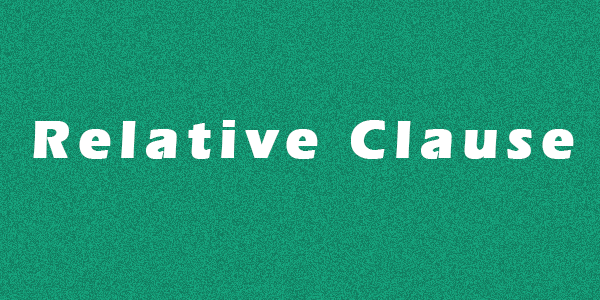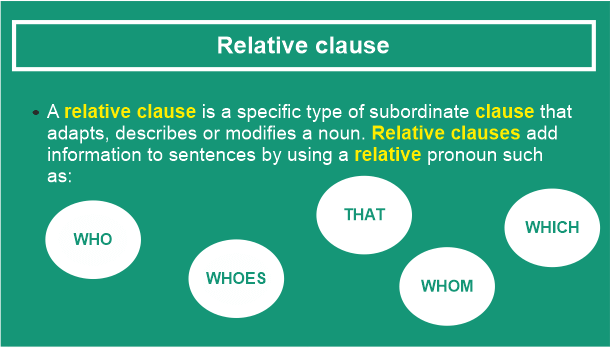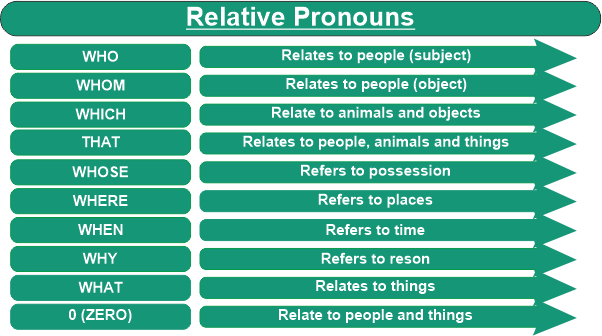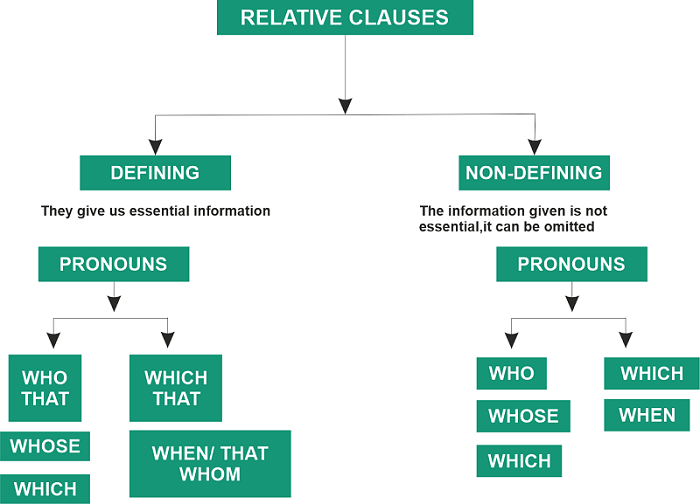Relative ClauseThis article will help you know what a relative clause is and how you can learn to use one. Relative clauses supplement sentences by providing more information. Here we shall describe how to recognize them in a sentence and provide recommendations to assist in its grammatical comprehension. 
What Are Relative Clauses?A relative clause is utilized to offer further details about the nouns. A relative clause is a type of subordinate clause in which a noun is adapted, described, or modified. They are preceded by a relative pronoun like 'that,' 'which,' 'who,' 'whose,' 'where,' or 'when.' Relative clauses appear immediately after the term to which they refer. This could occur at the conclusion of a sentence or in the center of the sentence. Whenever positioned in the midst of a sentence, the relative clauses are usually surrounded by comma. Relative clauses are sentence components that are optional. They may provide meaning, yet the sentence will still work properly if they are eliminated. In English, relative clauses are classified into two forms. It is critical to distinguish between them since it influences the pronoun used to initiate the clause. Defining relative clauses is used to provide crucial details about somebody or some object. It provides the information which we require to grasp what or who is being alluded to. A defining relative phrase is frequently followed by the term it describes. How Do You Define Relative Clauses?A relative clause is a kind of subordinate clause which provides more information about a noun. A relative pronoun - terms like who, whom, which, that, or whose - connects it to the main clause of a sentence. It's reliant since it's a subordinate sentence, which implies it doesn't make logical sense on its own. It must be linked to the primary clause of a sentence in order to make sense. 
What Is a Relative Clause Word?Relative clause words are used to construct complicated sentences by avoiding the use of the same pronoun two times in the same sentence. What Are Some Good Examples of Relative Clauses?Relative clauses supplement sentences with information by utilizing relative pronouns like who, that, or which. Below are a few instances of relative clauses with the relative clause highlighted.

What Exactly Are Relative Pronouns?A relative pronoun is a term that shows and links the dependent (or relative) clauses with the independent clauses. Relative pronouns include who, whom, what, which, and that. The phrase which starts with a relative pronoun is ready to answer inquiries like "Which one?" How many are there? Or What type? What Are the Various Forms of Relative Clauses?There are two basic forms of relative clauses. A noun or noun phrase is one sort of relative clause (these are defining and non-defining relative clauses). In contrast, the other type refers to a complete sentence or paragraph, particularly when speaking. Read on to know more about these two kinds of relative clauses. Defining versus non-defining relative clauses: A defining relative clause defines or describes the noun (or noun phrase) that follows it. In this instance, the relative sentence is in bold, while the individual or item being referenced to is underlined: She is going to show you the seats that are left. Relative clauses that refer to an entire sentence: The other kind of relative clause is one that refers to an entire sentence or stretch of text (they are often known as sentential relative clauses). Which is always used to show this type of relative clause. As an example: 
What Is a Defining Relative Clause?Defining relative clauses provides us with important details. This is info that informs us who or what we're discussing. To begin a defining relative sentence, we commonly employ a relative pronoun or adverb such as who, which, that, when, where, or whose. As an example: A defining or identifying clause indicates which particular individual or object is being discussed within a larger group of individuals or things. The meaning of the sentence changes significantly when a defining relative clause is eliminated. Commas or parentheses are not utilized to distinguish defining relative clauses from the body of the phrase.
What Is a Non-Defining Relative Clause?A non-defining or non-essential clause provides additional details about the individual or thing being discussed. We lose some detail when we eliminate a non-defining relative clause from a phrase, but the general meaning of the statement stays the same. Commas or parentheses are utilized to distinguish the non-defining relative clause from the remaining sentence.
How to Spot a Relative ClauseA relative clause, also known as an adjective or adjectival clause, must meet three criteria:
Individuals can use a basic pattern and formula to recognize a relative clause or even write their unique relative clause. Look at this dependable relative clause formula: Relative pronoun or Adverb + Subject + Verb = Relative clause An example of this formula in use : Uses Of a Relative ClauseAlthough using relative clauses in sentence construction could be natural and easy for English speakers, there are a few suggestions to follow if you aren't sure how to arrange them. 1. Describe how your clause contributes to the sentence. Whenever you insert a relative clause into your sentence, decide if it is restrictive or non-restrictive. Commas are not required for restrictive clauses that contribute crucial details to the meaning of your statement. Non-restrictive clauses, which provide additional details that a phrase can perform without, are denoted by commas. 2. Use the correct relative pronoun or adverb.. Your relative clause should start with a relative pronoun or adverb that expands on the noun it refers to. "Who" substitutes subject pronouns used to allude to individuals, and "whom" substitutes object pronouns used to refer to persons. When alluding to a possessive state, "whose" is utilized in non-restrictive clauses, "which" relates to objects and species, while "that" pertains to individuals and objects in restrictive clauses. Relative adverbs are utilized to expound on a location (through "where"), a time (by "when"), and the cause for something occurring (via "why"). 3. Use "-ing" to substitute the relative pronoun. To make your phrase more concise, add "-ing" to the verb inside your relative clause to replace a relative pronoun. "The person standing by the table has a great shirt," for example, is correct. Saying "sitting" enables you to remove the relative pronoun phrase "who is," which could come before that verb. How Should a Relative Clause Be Punctuated?Punctuating relative clauses can be challenging. It is crucial when you require the information provided by a relative clause. You must evaluate whether the relative clause is necessary or non-essential for each sentence and apply commas accordingly. Commas are not required for essential clauses. For instance; EssentialI spoke to the woman that was standing beside me. Non- EssentialThe girl, who was sitting beside me, informed me about her new project. The clause 'that was sitting beside me in the first instance is vital to the sentence and specifies who the girl is; therefore, we aren't required to punctuate it with commas. In the second example, however, the word 'who is sitting beside me is unnecessary because it just describes the girl in greater detail. As a result, we must employ commas to punctuate the clause. You might also use brackets or hyphens to punctuate a clause like this.
Next TopicRelative Clause Examples
|
 For Videos Join Our Youtube Channel: Join Now
For Videos Join Our Youtube Channel: Join Now
Feedback
- Send your Feedback to [email protected]
Help Others, Please Share










